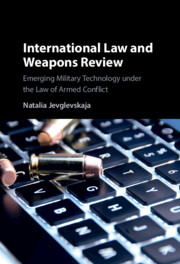Book contents
- International Law and Weapons Review
- International Law and Weapons Review
- Copyright page
- Dedication
- Contents
- Foreword
- Acknowledgements
- Table of Cases
- Table of Treaties and Other Selected Instruments
- Abbreviations
- 1 Introduction
- 2 Article 36: Background and Historical Development
- 3 Interpretative Methodology
- 4 Interpreting Article 36: The Object of Review
- 5 Interpretation of Article 36: The Process and Standard of Review
- 6 Weapons Review Obligation under Customary International Law
- 7 Weapons Reviews under the System of AP I
- 8 Challenges to Article 36 Reviews Posed by Autonomous Weapons Systems (AWS)
- 9 Challenges to Article 36 Reviews Posed by (Autonomous) Cyber Capabilities
- 10 Concluding Remarks
- Index
8 - Challenges to Article 36 Reviews Posed by Autonomous Weapons Systems (AWS)
Published online by Cambridge University Press: 16 December 2021
- International Law and Weapons Review
- International Law and Weapons Review
- Copyright page
- Dedication
- Contents
- Foreword
- Acknowledgements
- Table of Cases
- Table of Treaties and Other Selected Instruments
- Abbreviations
- 1 Introduction
- 2 Article 36: Background and Historical Development
- 3 Interpretative Methodology
- 4 Interpreting Article 36: The Object of Review
- 5 Interpretation of Article 36: The Process and Standard of Review
- 6 Weapons Review Obligation under Customary International Law
- 7 Weapons Reviews under the System of AP I
- 8 Challenges to Article 36 Reviews Posed by Autonomous Weapons Systems (AWS)
- 9 Challenges to Article 36 Reviews Posed by (Autonomous) Cyber Capabilities
- 10 Concluding Remarks
- Index
Summary
Chapter 8 looks at an Article 36 review of autonomous weapons systems. Having first addressed the progress of debates about potential future regulation of such systems at the international level, it delineates the notions of autonomy, artificial intelligence and learning systems. The chapter shows that military capabilities underpinned by machine learning and deep learning technologies require a new understanding of how provisions of targeting law can be meaningfully translated to the context of autonomous systems and examined in the framework of Article 36. It also demonstrates that determining the novel character of learning autonomous capabilities to ensure timely provision of legal advice, gaining assurance of complex adaptive systems’ performance accuracy and reliability, or identifying a set of requisite control measures, are all issues that ‘traditional’ weapons reviews do not have to grapple with at all, or at least not to the same extent. [143 words]
Keywords
- Type
- Chapter
- Information
- International Law and Weapons ReviewEmerging Military Technology under the Law of Armed Conflict, pp. 207 - 238Publisher: Cambridge University PressPrint publication year: 2021

